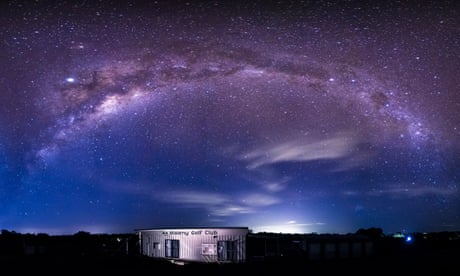- by foxnews
- 08 Apr 2025
Blinded by the light: how skyglow pollution is separating us from the stars
Blinded by the light: how skyglow pollution is separating us from the stars
- by theguardian
- 11 Dec 2022
- in news

On a clear dark Queensland night in 1997, Brendan Downs was staring up into the cosmos alongside a band of other amateur astronomers. He trained his telescope on a galaxy called NGC 6769, floating more than 169m light years away, and took a picture.
Downs went on to discover a second supernova, 2010dc, in his back yard Thunderchild Observatory in Ipswich, west of Brisbane, and has helped to confirm countless others.
Some researchers call light pollution cultural genocide. Generations of complex knowledge systems, built by Indigenous Australians and Torres Strait Islanders upon a once-clear view of the Milky Way, are being lost.
In the natural world, the mountain pygmy possum, a marsupial native to Australia, is critically endangered. Its main food source, the bogong moth, is being affected by artificial outdoor lighting messing with its migration patterns. Sea turtles are exhibiting erratic nesting and migration behaviours due to lights blasting from new coastal developments.
So how bright does our future look under a blanket of light?
Artificial lights at night cause skyglow in two ways: spill and glare. Light spills from a bulb when it trespasses beyond the area intended to be lit, while glare is a visual sensation caused by excessive brightness.
Streetlights contribute hugely to this skyglow and have been causing astronomers anxiety for decades.
But councils are choosing a type of LED that fails to meet standards designed by the Australasian Dark Sky Association (Adsa) to prevent harm to the environment and ourselves. They were drawn up in accordance with legislative requirements to protect ecosystems, wildlife, human health and comfort, and views of the night sky.
Dr Ken Wishaw, an Adsa co-founder, says cheap technologies present a major threat to the environment.
Blue-wavelength light typically emitted by high CCT LEDs may not be damaging to road users given a short exposure time, but impacts for wildlife and long-term exposure for humans are far more problematic.
Studies show that blue light may disrupt sleep patterns, with some suggesting links to mental illness, cancer, cardiovascular disease and other medical disorders.
In the Sunshine Coast hinterland town of Maleny, 100km north of Brisbane, more than 1,000 local people signed a petition to protect the last location in coastal south-east Queensland not heavily polluted by light. The petition calls for streetlights that comply with Australian government national light pollution guidelines and the Adsa criteria.
Local activists and project leaders are in discussions with council and government departments to push for widespread changes.
Campaigners say global united action on light sustainability guidelines is essential if humans are to manage our use of artificial light sources.
Our vision of the stars is always dated. The further you look into space, the further back in time you see.
How many stars can you see?
- by foxnews
- descember 09, 2016
Ancient settlement reveals remains of 1,800-year-old dog, baffling experts: 'Preserved quite well'
Archaeologists have recently unearthed the remarkably well-preserved remains of a dog from ancient Rome, shedding light on the widespread practice of ritual sacrifice in antiquity.
read more


